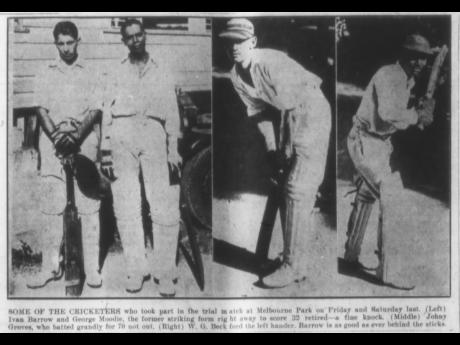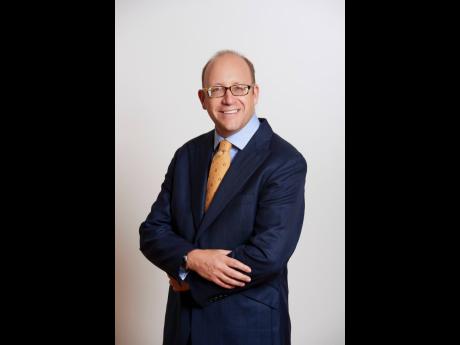Zaki Cooper and Daniel Lightman | Ivan Barrow – a cricketer worthy of fame and glory
As the cricket season comes to a close, the football season in England is getting under way. The world’s eyes will be on Old Trafford as the home of Manchester United, but earlier in the summer, it was the neighbouring cricket stadium that was everyone’s focus. The West Indies lost two Test Matches there, which led to a 2-1 loss in the series. But now is a good time to remember another Test between the two countries played at that ground in Manchester 87 years ago.
In 1933, Ivan Mordechai Barrow scored a Test century in the first innings of the second Test, which took place from July 22-25, 1933. Opening the innings – he was also the wicket-keeper – he scored 105.
Barrow was the first player from the Caribbean to score a Test century in England, just pipping his illustrious fellow Jamaican teammate George Headley to the landmark. Headley was 99 not out when Barrow reached three figures and went on to score a handsome 169. The two Jamaicans shared a partnership of 200 for the second wicket. “It was only natural that Barrow should have been overshadowed by his more famous partner,” noted Wisden, “but if there were several faults in his play, he showed skill in defence and a greater variety of strokes than was usually the case with him. He was at his best when driving and glancing to leg.”
Headley, whose exceptional batting led to his being nicknamed “the Black Bradman” (whereas his supporters called Bradman “the White Headley”) averaged 66 that series, amassing almost twice as many runs as the next batsman. In his book, A History of West Indies Cricket, former prime minister of Jamaica Michael Manley wrote that Headley “was denied the privilege of the first century in England when the young wicket-keeper and opening batsman, Ivan Barrow, got there first in the same innings”, but went on to add: “Barrow was a good player who deserved a place in history”.
The match at Old Trafford, which finished as a draw, was one of the high points of the West Indies’ 1933 tour. England won the other two Tests in the three-match series, and the tourists won only five of their 30 first-class matches that summer.
Barrow’s Test debut had come three years earlier at his home ground of Sabina Park in Jamaica when England toured the Caribbean from 1929-30. Unfortunately, his debut innings saw him bowled by Ewart Astill for a duck. He had the galling task of keeping wicket while England amassed the mammoth total of 849 – still their highest ever total against the West Indies.
BRADMAN’S FIRST WICKET
Barrow toured Down Under in 1930 and 1931. During that tour, he achieved the dubious (albeit noteworthy) distinction of being the first (of just two) batsman to be dismissed by Don Bradman in Test cricket. The highlight of his career, however, came on the Windies tour of England in 1933, in which he scored 1,046 runs and took 54 dismissals. He played the last of his 11 Tests in 1939, ending up with 276 runs (at an average of 16.23) and 22 dismissals (17 catches and five stumpings). Wisden called him “quiet and thoroughly competent”. His highest first-class score, 169, was made for Jamaica against Lord Tennyson’s team in March 1932. That innings also featured a lengthy partnership – this time of 248 – with George Headley, who made 140. Barrow followed up with 58 not out in the second innings, steering Jamaica to a victory by four wickets.
Barrow was a rarity, coming from the small Jewish community in Jamaica. He remains to this day the only Jewish cricketer to score a Test century – a landmark which just eluded South Africans Sid O’Linn (the victim of an outstanding catch by Colin Cowdrey for 98), Adam Bacher (twice dismissed for 96 in Test cricket), and the Australian Julien Wiener (who made his highest Test score, 93, in his final Test).
Ivan Barrow was born in 1911 in Jamaica to two Jewish parents, Hyam and Mamie Barrow. The Jewish community on the island dates back to when the Britain conquered Jamaica in 1655. Following this, the Jewish population grew and became more open although persecution from English merchants persisted. The first synagogue was built in Port Royal in the late 17th century, and another was built in the then capital, Spanish Town, following the earthquake of 1692. In 1885, the community built the striking, Shaare Shalom synagogue in Kingston. A small number of Jews continued to live on the island after Jamaica gained its independence from Britain in 1962.
Barrow’s upbringing featured the early years of his education at a Jewish school. His secondary-level education was at Wolmer’s Boys’ School in Kingston, which has had a track record of producing formidable cricketers, particularly wicket-keepers, and is often referred to as the ‘University of Cricket’.
Barrow died at age 68 in 1979 in Jamaica. One Jamaican newspaper reported that he had made “his fellow Jamaican Jews proud”. His century at Old Trafford was a significant moment not only for Caribbean cricket, but also for Jewish sportsmen. He may not have the fame of other swashbuckling Jamaican cricketers like George Headley, Courtney Walsh, and Chris Gayle, but his career is still remembered, particularly after a summer when England and the West Indies did battle twice at the scene of his great triumph at Old Trafford.
Zaki Cooper and Daniel Lightman have written numerous articles on cricket and are the co-authors of “Cricket Grounds from the Air” (with an introduction by Sir Geoffrey Boycott). Send feedback to dlightman@serlecourt.co.uk.




